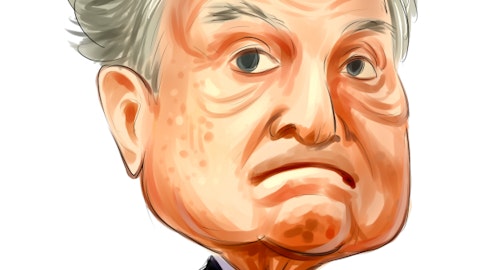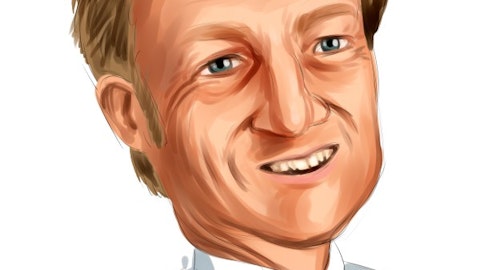John Zillmer: Yes, I’ll just add the final commentary on that. It’s – we are optimizing for growth retention and earnings improvement as a result of all the growth that we’re achieving and so we’re – we are focused on the margin. We get it. We understand that the marketplace will reward us for improving margins over time, but we think the best way to consistently deliver margin expansion is to grow the business and achieve that margin through scale and so we’re optimizing to achieve those objectives over a period of time and I’m not worried about 10 bps this year versus 20 bps next year. I’m more worried about achieving that sustainable growth model and maintaining it, and continuing to deliver for our customers’ day in and day out.
And the margin is an outcome of that strategy. It’s not the strategy. So we’re – we’re confident. We believe in the goals and we have the team in place to go ahead and deliver on it. And if we get lucky and inflation wanes more rapidly then you will see that translate into improved margin performance over time as well. And just very hard to predict where we are today as you probably saw CPI was unchanged in the announcement this morning, but CPI does not reflect the inflation rate that we project for food product around the world, which is closer to 5% or 6%. And our teams look at food inflation by business unit, by market basket, by product category, it’s a very detailed analytic that we have to evaluate it. And so we take that into our assumptions and if we have been conservative I think ultimately that plays well to our advantage as we continue to negotiate new terms, new agreements with our suppliers and with our customers.
Andrew Steinerman: Thank you, Tom. Thank you, John.
Operator: Our next question comes from Heather Balsky with BOA. Your line is open.
Heather Balsky: Hi, good morning. Thank you for taking my question. So to start, I was hoping you could talk about the cash flow statement, now that you have spun off Vestis, just what your free cash flow profile looks like, perhaps maybe help us shape what conversion looks like and any cadence around the cash flow quarter-to-quarter?
Tom Ondrof: Yes, the cadence shouldn’t change much at all because the Global FSS Business was really the driver of that seasonality. So you’ll again see a big outflow in Q1, big inflow in Q4 as you have seen in the past. Uniform’s cash flow was fairly consistent quarter-to-quarter throughout the year. So you’ll see the same cadence, just slightly lower numbers. In terms of conversion rate, we’re probably looking at about a 40% AOI conversion, as we settle out through this year and it’ll really stand up as a Food & Facilities only business, that probably is – is going to be the best benchmark. We’ve got a couple of things this year that are of note on free cash flow. So we do have some hangover transaction costs that we talked about from the spin that we’re paying in the first quarter roughly $35 million to $40 million.
And then we do have the taxes on AIM Service, the sale that we’ll pay in the first quarter as well about the same amount. I think overall that – that you – again, you’ll see the same cadence about a 40% AOI conversion as a target, bit less than that this year given these – those to one of items that I talked about.
Heather Balsky: Got it, that’s helpful. And then, as a follow-up question with regards to less a margin question, but more an operating question, over the last two years you’ve had to make adjustments with menu and your labor force and operations to help offset what we’re seeing with regard to inflation. As food costs inflation waves, it’s still there. How are you thinking about menu and operations? Can you unwind some of that? Or do you think this is sticky and you’re kind of happy where you are today?
John Zillmer: No, I think our – I think our operators have done a great job of adjusting menu and service offerings to meet – to meet the inflation issue head on and I think we’re largely through it. And so now, we’re really at a place where I think we have kind of a new normalized operating model and a new normalized menu structure, we don’t see the need for additional changes there. And I think the product supply issues that were prevalent over the course of the last couple of years have all essentially been normalized and so our people are really able to go ahead and structure the programs the way customers want them. So I think we’re very comfortable in today’s environment and we do believe that over time we’re getting back to a much more consistently normalized environment with respect to inflationary cost pressures both for food and labor, as labor availability has improved as well.
Heather Balsky: Thank you very much.
Operator: Our next question comes from Andrew Wittmann with Baird. Your line is open.
Andrew Wittmann: Oh great. Thanks for taking my questions guys. I guess I heard a couple of things in your remarks that are margin drivers. You talked about the maturing of all the new business that you sold recently in particular and that – that indicates to me like if you’re selling new business all the time, there should always be some new business that needs to mature. So if it’s going to give you a margin benefit, it might suggest that maybe your focus is more going to be on delivering the profit margin targets that you’ve set out here rather than maybe as aggressively growing the top line. Obviously, you always want to do both, but I guess, John, philosophically to hit the margin targets, do you have to pivot a little bit more to lean into the margin, the operational performance to deliver the above normal gains here over the next two or three years?
John Zillmer: Really no, we see growth as a path to margin expansion and that growing consistently over time leads to both AOI improvement in terms of a dollar – in terms of dollars and in terms of margin. And it comes from a couple of different sources handy is the – in both the growth in terms of the profitability from the new accounts that are added, which does scale up over time as well as the improved economics on supply chain spends. So as we add new business it provides additional spend for supply chain to manage to craft better deals with suppliers and manufacturers which leads to improved economics for everybody. So as you know, in the supply chain world you get paid for growth. And so we might get X number of dollars per case, if we’re buying at a certain level and we get X plus if we’re buying more.
So the growth feeds the supply chain economics and then it also creates additional leverage with respect to overhead because we don’t need to add significantly above unit costs when – as we’re growing the business. We’re able to grow the overheads at a rate that’s much slower than the growth rate of the company. So – so by maintaining that consistent growth profile over time, we deliver the margin expansion that we all – that we all seek, to shut the growth down or to focus more on margin as opposed to growth would actually be counterproductive and that’s frankly what the company did back in the mid teens, back in the earlier days post IPO. The company went on a margin march and stopped growing and that’s what led us to the point where we needed to make a significant strategic change.


